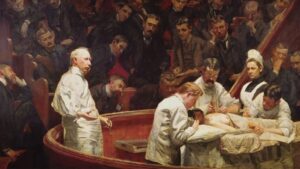The Evolution of Anesthesiology: A Historical Movement
The Birth of Modern Anesthesia (1846)
- William T.G. Morton’s Discovery: William T.G. Morton, a Boston dentist, discovered the use of ether as a safe and effective anesthetic agent. This was a groundbreaking moment in medical history, as it marked the beginning of modern anesthesia.
- First Successful Surgical Procedure with Anesthesia: Morton, along with surgeon John Collins Warren, performed the first successful surgical procedure with anesthesia on October 16, 1846. This procedure demonstrated the power of anesthesia in revolutionizing surgical care.
Development of Endotracheal Tubes
- Joseph O’Dwyer’s Contribution: Joseph O’Dwyer, a pediatrician, used metal “O’Dwyer” tubes in diphtheria cases and passed them into the trachea blindly. This was one of the first accounts of using endotracheal tubes for airway management.
- Cuffed Tubes and Positive Pressure Ventilation: Arthur Guedel and Ralph M. Waters added a cuff to the tube in 1932, enabling positive pressure ventilation. This innovation greatly improved the safety and effectiveness of endotracheal intubation.
Advances in Laryngoscopy
- Chevalier Jackson’s Handheld Laryngoscope: Chevalier Jackson promoted his handheld laryngoscope for endotracheal tube insertion. This device made it easier and safer to insert endotracheal tubes, reducing the risk of complications.
- Sir Robert Reynolds Macintosh’s Breakthrough Technique: Sir Robert Reynolds Macintosh developed a breakthrough technique of direct laryngoscopy in 1937, describing the routine placement of the laryngoscope in the epiglottic vallecula. This technique provided a better view of the larynx, making it easier to insert endotracheal tubes.
Intravenous Anesthetics
- Barbiturates and the Beginning of IV Anesthesia: Barbiturates were first used as intravenous anesthetics in 1932. This marked the beginning of IV anesthesia, which would go on to revolutionize the field of anesthesiology.
- Sodium Thiopental and Its Popularity: Sodium thiopental gained popularity after its use was described by Dr. John Lundy of the Mayo Clinic. This drug became a widely used IV anesthetic, known for its rapid onset and short duration of action.
- Propofol: A New Era in IV Anesthesia: Propofol, introduced in 1977, demonstrated many positive effects, including a shorter recovery period and suppression of laryngeal reflexes. This drug has become a popular choice for IV anesthesia, known for its rapid onset and short duration of action.
The Future of Anesthesiology
- Integration of New Technologies and Fields: The integration of evidence-based medicine, genetics, transplantation, imaging radiology, and stem cells into mainstream medicine promises an excellent future for anesthesiology. These advancements will continue to improve patient care and outcomes.
- Continued Progress and Advancements: The progress made in anesthesiology since 1846 has transformed the field, and we can expect continued advancements in the years to come. As new technologies and techniques emerge, anesthesiologists will continue to improve patient care and outcomes.

The Decade 1835-1845: Early Experimentation with Anesthetic Agents
Early Experimentation: Although many individuals administered anesthetic agents in the decade 1835-1845, they were not widely publicized and did not impact general medical practice.
Lack of Public Awareness: The use of anesthetic agents during this period was not widely known or accepted by the medical community.
The First Public Demonstration of Ether Anesthesia (1846)
William Morton and John Warren: On October 16, 1846, at Massachusetts General Hospital in Boston, the first public demonstration of ether anesthesia took place, performed by William Morton and John Warren.
The Operation: The operation was the removal of a lump under the jaw of Gilbert Abbott.
Witnesses: Present in the room was another surgeon, Jacob Bigelow, who wrote a letter to a friend in London describing the process.
Early Adoption of Ether Anesthesia in the UK (1846)
First Use in the UK: On December 19, 1846, ether anesthesia was used in both Dumfries and London.
James Robinson’s Use of Ether: In London, James Robinson, a dentist, removed a tooth from Miss Lonsdale under ether anesthesia.
Robert Liston’s Use of Ether: Two days later, Robert Liston amputated the leg of a chauffeur, Frederick Churchill, while a medical student, William Squires, gave an ether anesthetic.
The Impact of Anesthesia on Surgery
Reduced Suffering: The introduction of anesthesia greatly reduced the suffering of patients undergoing surgery.
Increased Surgical Possibilities: Anesthesia enabled surgeons to perform more complex operations, including those on the abdomen, chest, and brain.
Improved Surgical Practice: The evolution of surgical practice has been dependent on anesthesia and the concomitant introduction of antisepsis through Lister’s carbolic spray.
The Introduction of New Anesthetic Agents
Chloroform: Chloroform was introduced by James Simpson in November 1847, but it had more severe side effects, including the potential to cause sudden death and liver damage.
Local Anesthesia: The introduction of local anesthesia, such as cocaine, in 1877, allowed for more targeted pain relief.
Intravenous Induction Agents: The introduction of intravenous induction agents, such as barbiturates, enabled patients to go to sleep quickly and smoothly.
Advances in Airway Management and Muscle Relaxation
Control of the Airways: The use of tubes placed into the trachea allowed for control of breathing and techniques introduced in the 1910s were perfected in the late 1920s and early 1930s.
Muscle Relaxants: The introduction of muscle relaxants, such as curare, in the 1940s and 1950s, enabled surgeons to perform more complex operations.
Modern Anesthesia
Highly Trained Physicians: Anesthetists are now highly trained physicians who provide a whole range of care for patients, including preoperative optimization, High Dependency and Intensive Care Units, obstetric analgesia and anesthesia, and emergency medicine.
Improved Safety: Anesthesia is now very safe, with mortality of less than 1 in 250,000 directly related to anesthesia in most high-income countries.
Continued Improvement: The anesthetic profession will continue to strive for improvement over the next 150 years, driven by advances in monitoring systems and a greater understanding of bodily functions.



Comments (2)
Wilimson
October 28, 2021Lorem ipsum dolor sit amet, consectetur adipisicing elit, sed do eiusmod tempor incididunt ut labore et dolore magna aliqua. Ut enim ad minim veniam, quis nostrud exercitation ullamco laboris nisi ut aliquip ex ea commodo consequat.
Wilimson
October 28, 2021Lorem ipsum dolor sit amet, consectetur adipisicing elit, sed do eiusmod tempor incididunt ut labore et dolore magna aliqua. Ut enim ad minim veniam, quis nostrud exercitation.